Every time you buy a bag of coffee beans (good coffee, at least), somewhere on the packaging will tell you what roast it is. Maybe medium or dark roast? That makes up 90% of coffee, I’d say. But you’ve also got a light roast. And uh what about a French roast? Or a City+? Understanding these different coffee roasts is crucial if you want to brew a good cup.
This article is your complete buyer’s guide for your coffee beans. You’ll find out what type of roast is tastiest for all people, and other stuff like the strongest or the smoothest roast. That kinda jazz. First, let’s look at how the roasting process changes the taste of your coffee.
Different coffee roasts
Coffee beans are picked from the tree when they are green, and must be roasted before you can brew them. You can think of roasting a little like cooking the beans. The longer you roast, the darker the beans. This handy little graphic from HiLine Coffee Company shows how the beans change as you roast them.
Coffee beans for brewed coffee is usually called a light, medium or dark roast. When it comes to espresso coffee beans, more specific names are used like City, Vienna or French roast.

Lighter roasts retain more of the inherent flavors of the coffee, and they’re popular for single origins or washed coffees. You know, the ones with fabulous fruity or floral flavors.
Darker roasts lessen the sweeter flavors of the coffee and give more of a burnt, caramel-like taste. It’s a taste a lot of people prefer. Especially when it comes to espresso.
That said, every coffee is different and any coffee bean may be more suited to a particular roast.
Light Roast
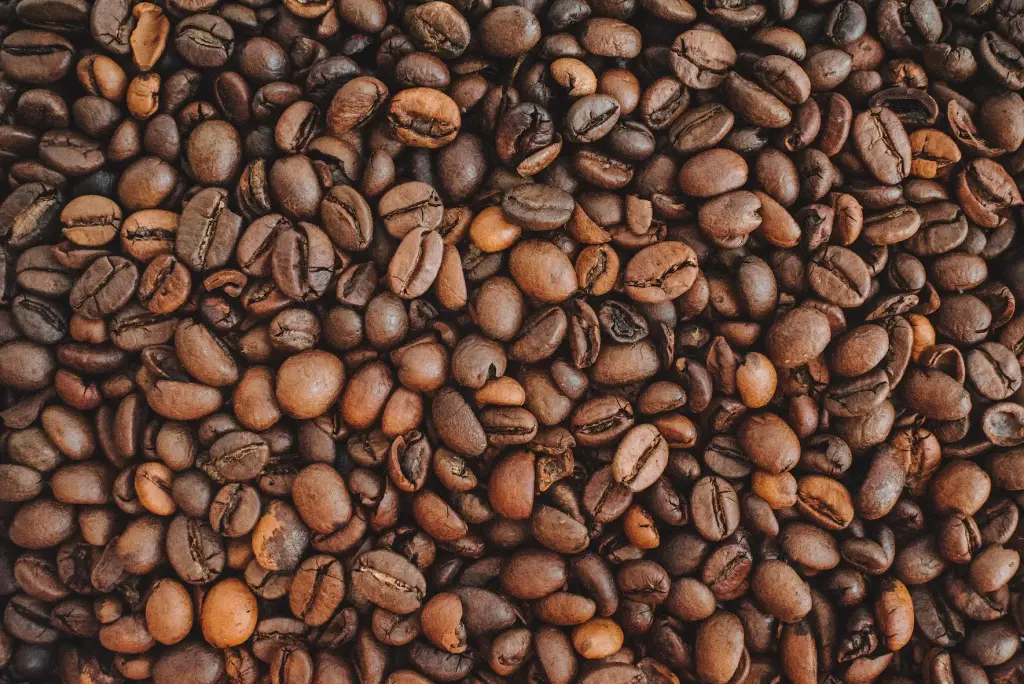
Coffee beans roasted to a light roast are a pale brown color with a little sheen from oil on the surface of the bean. The beans have been heated to a relatively low temperature and typically roasted to around the first crack.
Light roasts are the highest in acidity – often described as brightness – and lowest in bitterness. Brighter coffees are full of fruity, zesty and floral flavors with tasting indicators like melon, blueberries, jasmine and lemon.
They can also be quite an acquired taste, some people just don’t want their coffee tasting like a grapefruit.
Light roasts present some problems, too. They are less commonly used for espresso as it’s more difficult to dial in quality espresso shots – they have a tendency to produce an unpleasant sour taste. They are also notorious for being the most difficult roast to perfect for the roaster.
Medium Roast
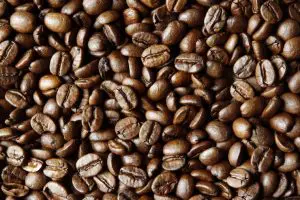
Coffee beans roasted to a medium roast are brown in color and have an oily sheen on the bean. Medium roasts are typically roasted to between the first and second crack.
This roast is considered the ideal in terms of balance of flavor and aroma. If a light roast has high acidity and low bitterness and a dark roasts have low acidity but high bitterness, here’s the middle ground.
The medium roast is the most common and popular roast, especially for high quality coffee.
Although light and dark roasts sound exotic, whereas medium roasts sound boring, honestly a good medium roast is your best bet 90% of the time. They are the best of both worlds, and give a great balance of flavors and smooth, smooth coffee.
Dark Roast
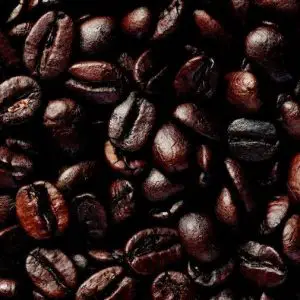
Coffee beans roasted to a dark roast become a dark brown color and have a oily sheen. They are brought to very high temperatures and are typically roasted up to and sometimes beyond the second crack.
Dark roasts are high in bitterness and low in acidity and at this point the high heat has destroyed much of the complexity of the coffee bean.
When you roast your beans to a certain temperature they will taste (and basically be) charred. You’re tasting carbon rather than coffee. This produces a cup that tastes burnt, smoky, bitter and retains little of the natural flavor of the coffee bean.
This is not necessarily bad. Many people love a burnt tasting coffee. That burnt, smoky, charred taste is what they associate with coffee and what they want to taste.
But it’s for this reason that much bad coffee is dark roast. You may notice that lots of instant coffee use dark roasts as a way to mask the deadness of the flavor and texture.
What type of coffee roast is best for espresso?
Espresso coffee suits darker roasts like a City, Full City, French or Vienna — closer to or past the second crack. In fact, you only hear those names when it comes to espresso.
The reason is the high-heat and high-pressure brewing of espresso can amplify the flavor, sometimes in a BAD way. So your delicate, fruity single origin ends up a bitingly harsh acidic mess. Nothing more frustrating than pulling sour shot after sour shot.
With dark roasts, the sugars have had time to caramelize, and the caramel softens the harsher notes in the coffee bean.
Which coffee roast is the strongest?
Caffeine is remarkably stable throughout the coffee roasting process. This means that if you take one bean of light roast and one beans of dark roast that are otherwise identical, the difference in caffeine between the two is negligible. You might think otherwise, and that’s because of a big misconception. Let me explain…
I’ve heard it time and time again that lighter roasts have more caffeine, and so are stronger. The thinking goes that caffeine is somehow “burnt away” during the roast. The longer the roast? The less caffeine. But this simply isn’t true.
You could argue that dark roasts contain less water? This means there is more coffee (and less water weight) in any given bag of coffee, and therefore more caffeine. So going purely by weight, you get a little more caffeine with the dark roast. But honestly, it’s not much difference.
Note: if by “strongest” you mean like the intensity of flavor, that’s more to do with how you brew. Use more coffee and less water, that’ll make your coffee stronger. A typical coffee-to-water ratio is 1:15. Bring it down to 1:12 or 1:10 and see if it’s strong enough for ya.
What is a good coffee roast for beginners?
The best coffee roast for beginners is — in my humble opinion — a medium roast. A light roast can be a little too acidic and off putting with its brighter flavors. A dark roast doesn’t bring out the flavors of the bean enough, and may give a poor impression of how coffee can taste to a newbie. On the other hand…
A medium roast makes balanced, smooth coffee. And that’s exactly where you want to start as a beginner. You can figure out the rest later.
Which coffee roast is the smoothest?
The smoothest coffee roast for most coffee beans is a medium roast. A light roast highlights the sweeter, more acidic flavors whereas a dark roast can taste burnt, bitter and charred. A medium roasts sits right in the middle, and generally gives the smoothest coffee.
It’s for this reason, too, that medium roast is the most popular roast of coffee you’ll find, and often considered the best roasts of coffee as well,
Which roast is the least bitter?
The least bitter coffee roast is a light roast. This is because the roasting process burns the coffee beans and imparts darker, burnt, charred and bitter tastes. The less you roast? The less bitterness. There is one important caveat though:
Sipping a coffee and tasting bitterness is not all about the roast. Don’t think you can buy yourself a pretty bag of light roasted coffee and it can’t taste bitter. If you mess up the brewing process and overextract? That can make you coffee bitter. Likewise, a bad roast can mess it up, too.
All things being equal though, a light roast is the way to go for coffee that isn’t bitter.
Why are coffee beans roasted?
When you grow coffee you make the Coffea plant which produces coffee cherries like this.
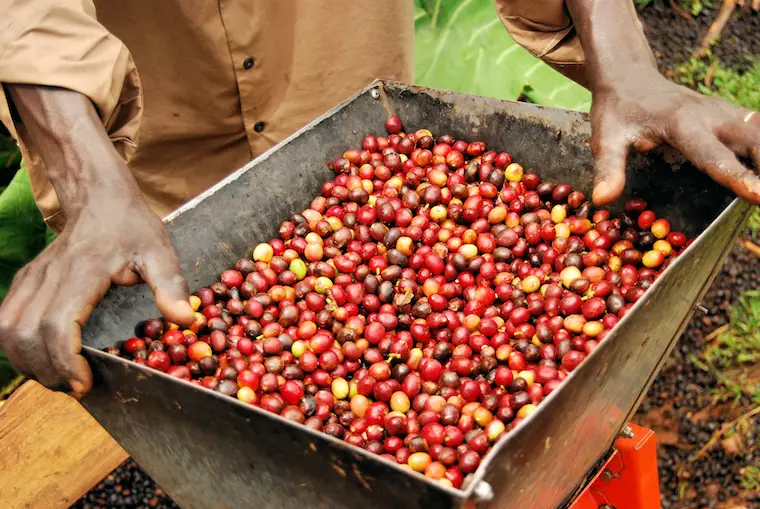
Inside these coffee cherries are one or two green coffee beans. These are extracted from the cherry using a number of processing techniques.
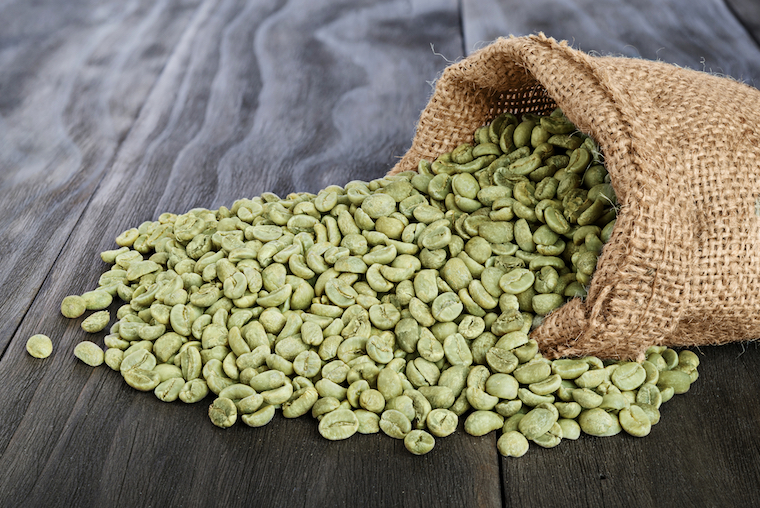
Green coffee beans have a grassy, piney smell and, crucially, they are raw and soft. Basically, you can’t grind them up and brew coffee with them. Roasting these green coffee beans makes them more brittle and so suitable for being ground up.
How is coffee roasted?
Coffee is roasted by heating the coffee beans up, and it’s a lot like cooking them. Ever tried roasting your own peanuts or cashew nuts? It’s a little like that.
Roasting coffee doesn’t take long, maybe 10-20 minutes? It’s a simple process. You can even buy some green coffee beans yourself and cook them in on your stove in a pain. The coffee beans you buy in shops or at a dedicated roasters will use commercial roasting equipment like in the photo here.
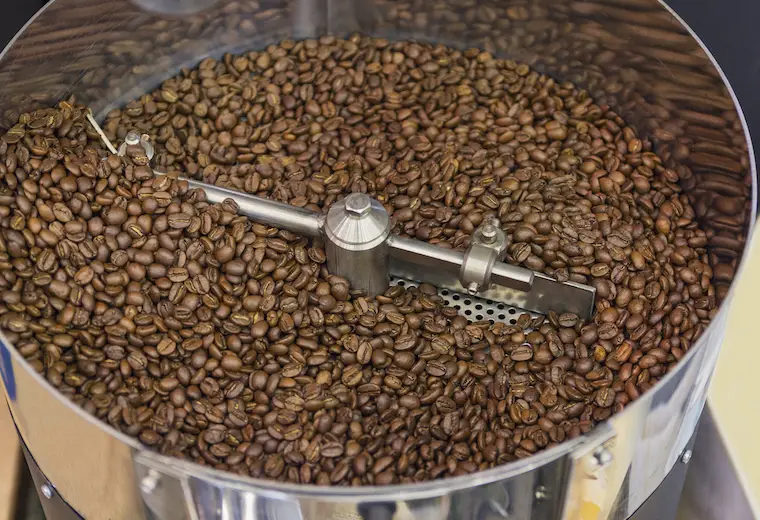
As you heat up your coffee beans when roasting them, they change color. First, turning from a green into a pale yellow, then getting more and more brown. Two important parts of this is the first and second crack. Let me explain…
First crack
The first crack is the sounds of the coffee beans making a “pop” or “crackle”. It sounds lots of individual crackling noises and comes from the coffee beans popping as the water inside the bean is evaporated, and the pressure force the coffee bean to expand.
It’s a sign that the roasting process is truly underway, and happens when the temperature of the beans reaches about 196°C (385°F).
The coffee beans will be a light brown at this point. Also, this is about when the roast can first be considered finished. Ending the roast here will result in a light roast.
If you keep roasting towards the second crack, then the sugars in the coffee bean begin to caramelize. This changes the taste from acidic and fruity to burnt and chocolatey very quickly.
This process is what makes the color of the bean become a dark brown. Medium roasts, known for their balanced flavors, fall somewhere in this range.
Second crack
The second crack comes a few minutes later in the roasting process and makes a less loud crackling sound as the first crack. Now the temperature of the beans has reached around 225°C (437°F).
This crack happens because of the oils inside the coffee now reaching the surface of the bean. You can tell because at this point, the coffee beans should be a dark brown and have a noticeably oily sheen to them
Shortly after second crack is considered the point where the beans become a dark roast. Now, the sugars have caramelized which gives the dark, smoky taste of a darker roast. Take care not to roast too long. If you do, the burnt and charred flavors will take over.
It’s worth mentioning that after the roast, it takes a little while for the coffee beans to hit their peak flavor. You’re going to want to leave it at least a day or two for the coffee to degas or the CO2 from the roasting will ruin your coffee. Also, for best results, brew and drink your coffee within a month.
Which roast is healthier?
On the whole, coffee is coffee. So whichever roasts you are drinking will have the same benefits and drawbacks to health. However, it has been shown that lighter roasts have more antioxidants and better anti-inflammation effects than darker roasts. You can read more about the study on this, here.
Which roast is more bitter?
Dark roast will produce a heavier, smokier and more bitter taste. But unpleasant bitter flavors are less about the roast and more about poor quality coffee beans or mediocre roasting and brewing. Don’t be put off by dark roast coffee thinking it’s all bitter. It’s not.
What is a blonde roast?
It’s a term Starbuck’s made up to make their light roast sound nicer. Go figure.
Conclusion
As you can see, a lot goes into the roast of your coffee. Actually, too much. It’s far too great a topic for the average buyer to understand, even if you’re a coffee nerd like I am.
So what do you do? Honestly, the best thing you can do for your coffee is to buy from a high quality roaster. A place that really knows their stuff. Get that, and it doesn’t matter whether you buy a dark roast or anything else, because the roaster will choose the roast depending on the flavor profile of the bean.
I always recommend looking for a good roaster that’s local to you. They’re everywhere these days, and here’s my guide on how to find the best one near you. Online roasters can be a good option, too.
And if you’re really brave? Well, try picking up some green coffee beans and learn to roast your own. You can get started with some green coffee and a frying pan. But it’s like the old phrase, “easy to learn, difficult to master”.

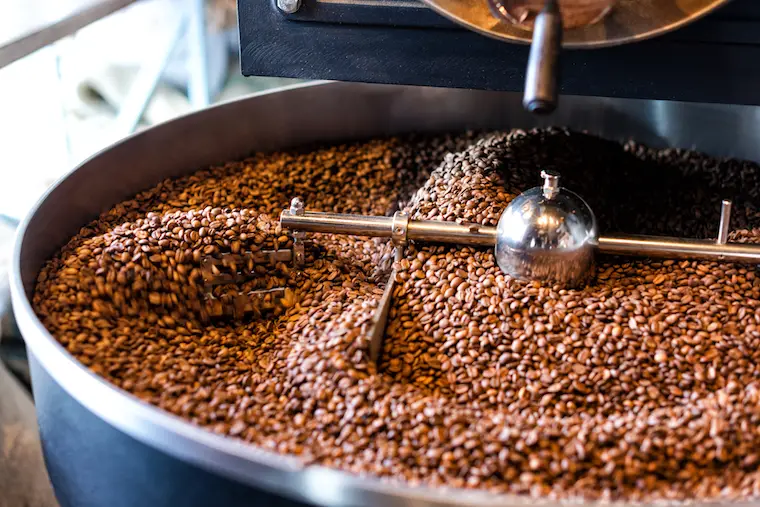
1 Comment
Wonderful article! I think it will be fun to roast my own coffee beans!